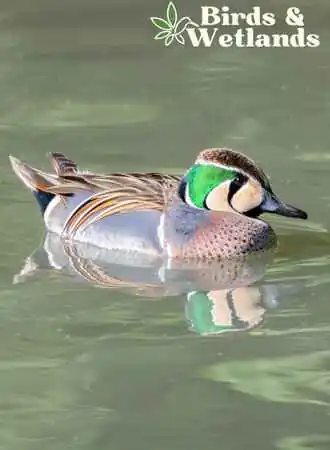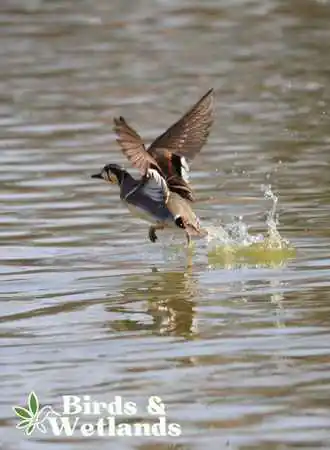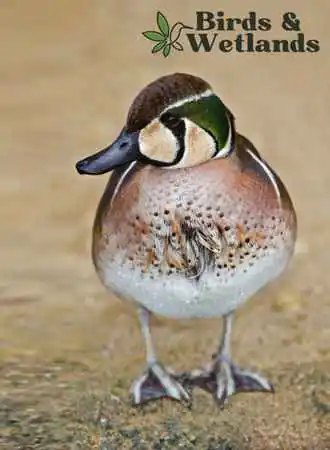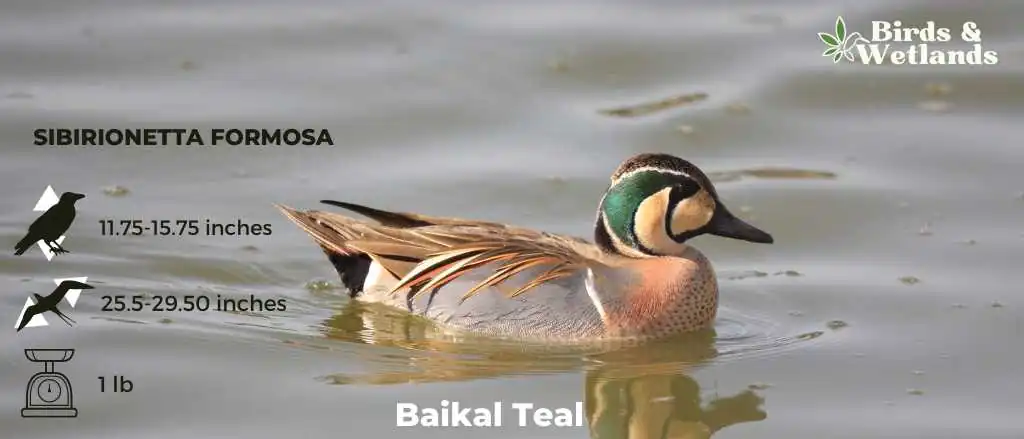The Baikal teal (Anas formosa or Sibirionetta formosa) is a small duck found in eastern Russia, China, and Mongolia lakes and rivers. It is named after Lake Baikal, one of the world’s largest freshwater lakes, where it is a common sight.
The Baikal teal is known for its distinctive coloring, with a chestnut head, green-grey wings, and a white belly. It is also a skilled diver, able to plunge underwater to forage for food.
Scientific Name: Sibirionetta formosa
Height: 11.75 to 15.75 inches
Wingspan: 65–75 cm
Weight: 1 pound
Physical Characteristics
The Baikal teal is a small duck with a body length of around 16-18 inches and a wingspan of 24-26 inches.
The top of the head of the drake is black and dark brown, while the sides of the face are pale buff. A white line runs from the eye to the throat, separating the face from a metallic green crescent extending from the rear eye down to the neck. Its wings are green-grey, with a distinctive white stripe running along the upper edge.
There is also a white spot near the base of its bill or beak.
The female looks like the green-winged teal but has a distinctive white spot and a longer tail. The male looks similar to the female during the non-breeding season.
One of the unique adaptations of the Baikal teal is its ability to dive underwater to forage for food. Unlike many other ducks, which feed on the surface of the water, the Baikal teal can dive to depths of up to 10 feet in search of aquatic plants, insects, and small fish.
The Baikal teal also has webbed feet, which are well-suited to its aquatic habitat and help it to swim quickly and efficiently. Additionally, these birds have a relatively high body fat content, which allows them to withstand cold temperatures.

Listen to the Baikal Teal
Habitat & Behavior

The natural habitat of the Baikal teal is the rivers of eastern Russia, China, and Mongolia. It is particularly common in the region around Lake Baikal.
The Baikal teal prefers shallow, marshy areas with abundant aquatic vegetation and grasses, where it can easily find food and shelter. It is also typically found near open water, where it can take off and land easily.
The Baikal teal migrates long distances. Some populations travel from Siberia to South Korea, southern Japan and some parts of east Asia, searching for food and suitable wintering grounds.
Currently, it is yet to be discovered if any populations of Baikal teal migrate to North America. While some birds migrate to North America in the winter, the Baikal teal is not typically considered among them. Some individual Baikal teals may occasionally visit Alaska, but it is unknown if this is a common occurrence.
The Baikal teal is a social bird known to engage in playful behaviors, such as “duck wrestling,” where two individuals push and shove each other with their beaks. It is also known to use its wings to splash water on its back, which may serve to clean the feathers or regulate its body temperature.

Diet
The Baikal teal feeds on various aquatic plants, insects, water snails and small fish in the wild. It is a skilled diver, able to plunge underwater to forage for food. It feeds on a range of aquatic plants, including various species of algae and water weeds.
This duck also feeds on various insects, such as beetles, flies, and mollusks, which it finds in the water or along the shoreline.
Occasionally, these birds also feed on small fish, such as minnows and sticklebacks, which they catch using their sharp beaks. In addition to these foods, it may also eat seeds and berries it finds in its environment.

Reproduction
The Baikal teal breeds in the taiga and tundra regions of central and eastern Siberia.
In the spring, the Baikal teal typically breeds in small, isolated groups, with each pair forming a bond and establishing a territory. The female lays a clutch of 6-9 pale green eggs in her nest, which the female incubates for 25 to 30 days. All eggs hatch simultaneously.
During incubation, drakes join others to molt near their breeding grounds.
The ducklings fledge at about 45 to 55 days and reach sexual maturity at one year.

Population & Conservation Status
Before 2011, this duck was considered a threatened species. Currently, it is assigned the “Least Concern” conservation status and was removed from the IUCN red list. The Baikal teal’s main threats include habitat loss, hunting, and environmental pollution.
Like many other waterfowl species, the Baikal teal is vulnerable to habitat loss due to the destruction and degradation of its natural habitat.
To address these threats, conservation efforts are being made to protect the Baikal teal and its habitat.
In Russia, the Baikal teal is protected under federal law, and hunting of the species is strictly regulated. Additionally, several protected areas have been established in the Baikal teal range, including national parks and wildlife reserves. These protected areas help to conserve the bird’s natural habitat and provide a haven for the species to breed and feed.

Key Points
- These birds inhabit wetland habitats where they can be seen feeding both aquatic plants and small animals.
- Females lay 6 to 9 eggs in their nests and incubate the without the help of the males.
- These wildfowl are native to the area surrounding Lake Baikal.


